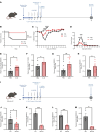IL-33 protects from recurrent C. difficile infection by restoration of humoral immunity
- PMID: 40048372
- PMCID: PMC12043089
- DOI: 10.1172/JCI184659
IL-33 protects from recurrent C. difficile infection by restoration of humoral immunity
Abstract
Clostridioides difficile infection (CDI) recurs in 1 of 5 patients. Monoclonal antibodies targeting the virulence factor TcdB reduce disease recurrence, suggesting that an inadequate anti-TcdB response to CDI leads to recurrence. In patients with CDI, we discovered that IL-33 measured at diagnosis predicts future recurrence, leading us to test the role of IL-33 signaling in the induction of humoral immunity during CDI. Using a mouse recurrence model, IL-33 was demonstrated to be integral for anti-TcdB antibody production. IL-33 acted via ST2+ ILC2 cells, facilitating germinal center T follicular helper (GC-Tfh) cell generation of antibodies. IL-33 protection from reinfection was antibody-dependent, as μMT KO mice and mice treated with anti-CD20 mAb were not protected. These findings demonstrate the critical role of IL-33 in generating humoral immunity to prevent recurrent CDI.
Keywords: Adaptive immunity; Immunology; Infectious disease.
Figures








Update of
-
IL-33 protects from recurrent C. difficile infection by restoration of humoral immunity.bioRxiv [Preprint]. 2024 Nov 17:2024.11.16.623943. doi: 10.1101/2024.11.16.623943. bioRxiv. 2024. Update in: J Clin Invest. 2025 Mar 6;135(9):e184659. doi: 10.1172/JCI184659. PMID: 39605647 Free PMC article. Updated. Preprint.
References
MeSH terms
Substances
Grants and funding
LinkOut - more resources
Full Text Sources
Research Materials
Miscellaneous

